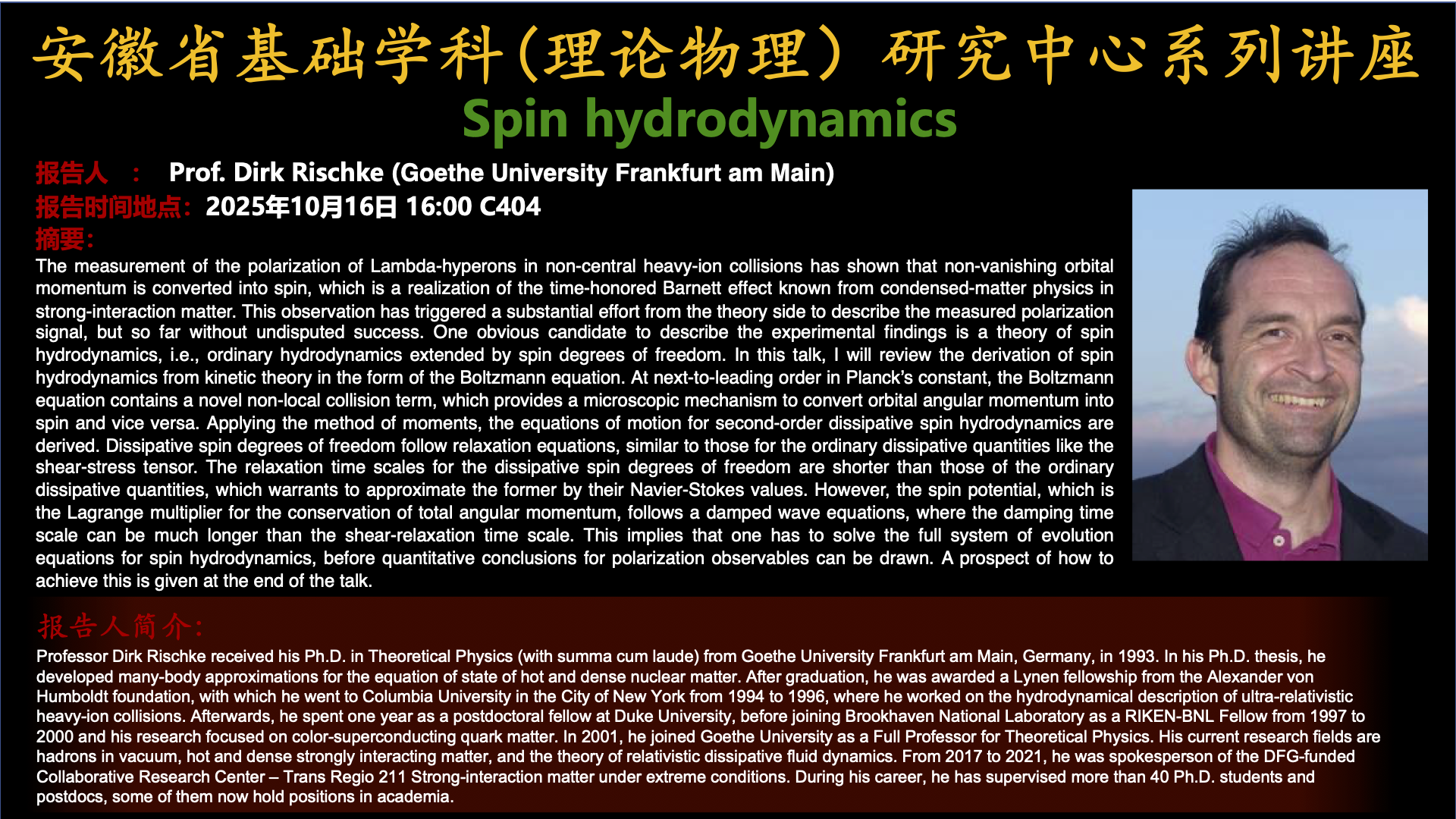Rischke, Spin hydrodynamics
报告人: Prof. Dirk Rischke (Goethe University Frankfurt am Main)
报告时间地点:2025年10月16日 16:00 C404
摘要:
The measurement of the polarization of Lambda-hyperons in non-central heavy-ion collisions has shown that non-vanishing orbital momentum is converted into spin, which is a realization of the time-honored Barnett effect known from condensed-matter physics in strong-interaction matter. This observation has triggered a substantial effort from the theory side to describe the measured polarization signal, but so far without undisputed success. One obvious candidate to describe the experimental findings is a theory of spin hydrodynamics, i.e., ordinary hydrodynamics extended by spin degrees of freedom. In this talk, I will review the derivation of spin hydrodynamics from kinetic theory in the form of the Boltzmann equation. At next-to-leading order in Planck’s constant, the Boltzmann equation contains a novel non-local collision term, which provides a microscopic mechanism to convert orbital angular momentum into spin and vice versa. Applying the method of moments, the equations of motion for second-order dissipative spin hydrodynamics are derived. Dissipative spin degrees of freedom follow relaxation equations, similar to those for the ordinary dissipative quantities like the shear-stress tensor. The relaxation time scales for the dissipative spin degrees of freedom are shorter than those of the ordinary dissipative quantities, which warrants to approximate the former by their Navier-Stokes values. However, the spin potential, which is the Lagrange multiplier for the conservation of total angular momentum, follows a damped wave equations, where the damping time scale can be much longer than the shear-relaxation time scale. This implies that one has to solve the full system of evolution equations for spin hydrodynamics, before quantitative conclusions for polarization observables can be drawn. A prospect of how to achieve this is given at the end of the talk.
报告人简介:
Professor Dirk Rischke received his Ph.D. in Theoretical Physics (with summa cum laude) from Goethe University Frankfurt am Main, Germany, in 1993. In his Ph.D. thesis, he developed many-body approximations for the equation of state of hot and dense nuclear matter. After graduation, he was awarded a Lynen fellowship from the Alexander von Humboldt foundation, with which he went to Columbia University in the City of New York from 1994 to 1996, where he worked on the hydrodynamical description of ultra-relativistic heavy-ion collisions. Afterwards, he spent one year as a postdoctoral fellow at Duke University, before joining Brookhaven National Laboratory as a RIKEN-BNL Fellow from 1997 to 2000 and his research focused on color-superconducting quark matter. In 2001, he joined Goethe University as a Full Professor for Theoretical Physics. His current research fields are hadrons in vacuum, hot and dense strongly interacting matter, and the theory of relativistic dissipative fluid dynamics. From 2017 to 2021, he was spokesperson of the DFG-funded Collaborative Research Center – Trans Regio 211 Strong-interaction matter under extreme conditions. During his career, he has supervised more than 40 Ph.D. students and postdocs, some of them now hold positions in academia.
Talk video: link
